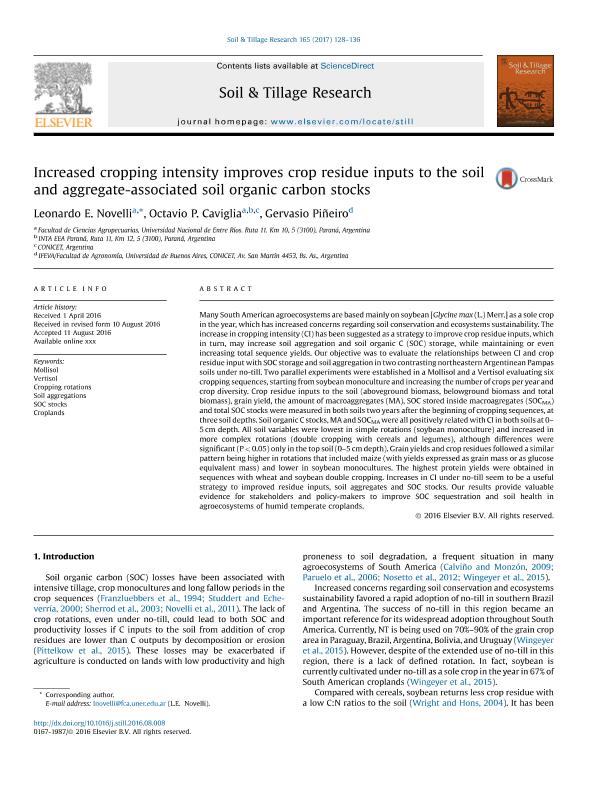Mostrar el registro sencillo del ítem
dc.contributor.author
Novelli, Leonardo Esteban

dc.contributor.author
Caviglia, Octavio Pedro

dc.contributor.author
Piñeiro, Gervasio

dc.date.available
2018-04-03T21:12:03Z
dc.date.issued
2017-01
dc.identifier.citation
Novelli, Leonardo Esteban; Caviglia, Octavio Pedro; Piñeiro, Gervasio; Increased cropping intensity improves crop residue inputs to the soil and aggregate-associated soil organic carbon stocks; Elsevier Science; Soil & Tillage Research; 165; 1-2017; 128-136
dc.identifier.issn
0167-1987
dc.identifier.uri
http://hdl.handle.net/11336/40601
dc.description.abstract
Many South American agroecosystems are based mainly on soybean [Glycine max (L.) Merr.] as a sole crop in the year, which has increased concerns regarding soil conservation and ecosystems sustainability. The increase in cropping intensity (CI) has been suggested as a strategy to improve crop residue inputs, which in turn, may increase soil aggregation and soil organic C (SOC) storage, while maintaining or even increasing total sequence yields. Our objective was to evaluate the relationships between CI and crop residue input with SOC storage and soil aggregation in two contrasting northeastern Argentinean Pampas soils under no-till. Two parallel experiments were established in a Mollisol and a Vertisol evaluating six cropping sequences, starting from soybean monoculture and increasing the number of crops per year and crop diversity. Crop residue inputs to the soil (aboveground biomass, belowground biomass and total biomass), grain yield, the amount of macroaggregates (MA), SOC stored inside macroagregates (SOCMA) and total SOC stocks were measured in both soils two years after the beginning of cropping sequences, at three soil depths. Soil organic C stocks, MA and SOCMA were all positively related with CI in both soils at 0–5 cm depth. All soil variables were lowest in simple rotations (soybean monoculture) and increased in more complex rotations (double cropping with cereals and legumes), although differences were significant (P < 0.05) only in the top soil (0–5 cm depth). Grain yields and crop residues followed a similar pattern being higher in rotations that included maize (with yields expressed as grain mass or as glucose equivalent mass) and lower in soybean monocultures. The highest protein yields were obtained in sequences with wheat and soybean double cropping. Increases in CI under no-till seem to be a useful strategy to improved residue inputs, soil aggregates and SOC stocks. Our results provide valuable evidence for stakeholders and policy-makers to improve SOC sequestration and soil health in agroecosystems of humid temperate croplands.
dc.format
application/pdf
dc.language.iso
eng
dc.publisher
Elsevier Science

dc.rights
info:eu-repo/semantics/openAccess
dc.rights.uri
https://creativecommons.org/licenses/by-nc-sa/2.5/ar/
dc.subject
Mollisol
dc.subject
Vertisol
dc.subject
Rotations
dc.subject
Aggregation
dc.subject.classification
Meteorología y Ciencias Atmosféricas

dc.subject.classification
Ciencias de la Tierra y relacionadas con el Medio Ambiente

dc.subject.classification
CIENCIAS NATURALES Y EXACTAS

dc.subject.classification
Meteorología y Ciencias Atmosféricas

dc.subject.classification
Ciencias de la Tierra y relacionadas con el Medio Ambiente

dc.subject.classification
CIENCIAS NATURALES Y EXACTAS

dc.title
Increased cropping intensity improves crop residue inputs to the soil and aggregate-associated soil organic carbon stocks
dc.type
info:eu-repo/semantics/article
dc.type
info:ar-repo/semantics/artículo
dc.type
info:eu-repo/semantics/publishedVersion
dc.date.updated
2018-04-03T18:27:18Z
dc.journal.volume
165
dc.journal.pagination
128-136
dc.journal.pais
Países Bajos

dc.journal.ciudad
Amsterdam
dc.description.fil
Fil: Novelli, Leonardo Esteban. Consejo Nacional de Investigaciones Científicas y Técnicas; Argentina. Universidad Nacional de Entre Ríos. Facultad de Ciencias Agropecuarias; Argentina
dc.description.fil
Fil: Caviglia, Octavio Pedro. Universidad Nacional de Entre Ríos. Facultad de Ciencias Agropecuarias; Argentina. Instituto Nacional de Tecnología Agropecuaria. Centro Regional Entre Ríos. Estación Experimental Agropecuaria Paraná; Argentina. Consejo Nacional de Investigaciones Científicas y Técnicas; Argentina
dc.description.fil
Fil: Piñeiro, Gervasio. Consejo Nacional de Investigaciones Científicas y Técnicas. Oficina de Coordinación Administrativa Parque Centenario. Instituto de Investigaciones Fisiológicas y Ecológicas Vinculadas a la Agricultura. Universidad de Buenos Aires. Facultad de Agronomía. Instituto de Investigaciones Fisiológicas y Ecológicas Vinculadas a la Agricultura; Argentina
dc.journal.title
Soil & Tillage Research

dc.relation.alternativeid
info:eu-repo/semantics/altIdentifier/doi/http://dx.doi.org/10.1016/j.still.2016.08.008
dc.relation.alternativeid
info:eu-repo/semantics/altIdentifier/url/https://www.sciencedirect.com/science/article/pii/S0167198716301672
Archivos asociados
